
St. James Town is a neighbourhood of Toronto, Ontario, Canada. It lies in the northeast corner of the downtown area. The neighbourhood covers the area bounded by Jarvis Street to the west, Bloor Street East to the north, Parliament Street to the east, and Wellesley Street East to the south.

Front Street is an east–west road in downtown Toronto, Ontario, Canada. First laid out in 1796, the street is one of the original streets of the Town of York. The street was laid out along the shoreline of Lake Ontario as it existed during that time. It remains an important street, with many important uses located along it, including the St. Lawrence Market, Meridian Hall, Union Station and the Metro Toronto Convention Centre. The eastern section of Front Street, in the West Don Lands, east of Cherry Street, is being rebuilt as a broad tree-lined boulevard, intended to be the pedestrian-friendly commercial spine of the new neighbourhood.

Jarvis Collegiate Institute is a high school in Toronto, Ontario, Canada. It is named after Jarvis Street where it is located. It is a part of the Toronto District School Board (TDSB). Prior to 1998, it was within the Toronto Board of Education (TBE).
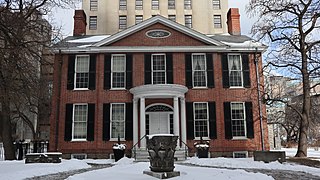
Campbell House is an 1822 heritage house and museum in downtown Toronto, Ontario, Canada. It was built for Upper Canada Chief Justice Sir William Campbell and his wife Hannah. The home was designed for entertaining and comfort, and constructed at a time when the Campbells were socially and economically established and their children had grown to adulthood. The house is one of the few remaining examples of Georgian architecture left in Toronto and is constructed in a style in vogue during the late Georgian era known as Palladian architecture.

The Garden District is a neighbourhood in downtown Toronto, Ontario, Canada. The name was selected by the Toronto East Downtown Residents Association (TEDRA) in recognition of Allan Gardens, an indoor botanical garden located nearby at the intersection of Carlton and Jarvis Streets. The Garden District was officially designated by the Mayor and Toronto City Council in 2001, while TEDRA has since been renamed the Garden District Residents Association. Part of the neighbourhood is within official City of Toronto neighbourhood of Moss Park.

Saint Luke's United Church is located at 353 Sherbourne Street in Toronto, Ontario, Canada. Originally built across the street from the old site of Toronto General Hospital, it is now across from Allan Gardens. The building was originally home to Sherbourne Street Methodist Church, later Sherbourne United. It merged with Carlton Street United in 1959 to create St. Luke's. Sherbourne was founded in 1872, while Carlton originated in 1832.

German Mills is a community within the city of Markham in Ontario, Canada. The easternmost community in the historic town of Thornhill, German Mills was named for the early German settlers in the area.
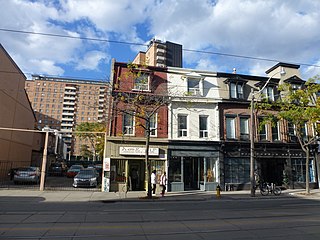
Moss Park is a residential neighbourhood located in downtown Toronto, Ontario, Canada. The area known as Moss Park is typically considered to be between Jarvis Street and Parliament Street, south of Dundas Street, an area dominated by public housing projects. According to one set of boundaries of the City of Toronto, it is roughly L-shaped, bounded on the north by Carlton Street to Parliament Street, on the east by Parliament Street to Queen Street East and the Don River, on the south by Eastern Avenue and Front Street, and on the west by Jarvis Street. This larger concept of the area includes the neighbourhoods known as Corktown and the Garden District, as well as a portion of Cabbagetown.

Inglenook Community High School is a Toronto public high school which offers grade 10, 11, and 12 level courses. It is housed in an historical building designed by William George Storm in Corktown, in downtown Toronto, Ontario. The school has, on average, one hundred students and six teachers. It is located in the oldest continually-operated school building of the Toronto District School Board.
Thornton Blackburn (1812–1890) was a self-emancipated formerly enslaved man whose case established the principle that Canada would not return slaves to their masters in the United States and thus established Canada as a safe terminus for the Underground Railroad.

The Ward was a neighbourhood in central Toronto, Ontario, Canada, in the 19th and early 20th centuries. Many new immigrants first settled in the neighbourhood; it was at the time widely considered a slum.

Jarvis Street is a north-south thoroughfare in downtown Toronto, Ontario, Canada, passing through some of the oldest developed areas in the city. Its alignment extends from Queens Quay East in the south to Bloor Street in the north. The segment south of Front Street is known as "Lower Jarvis Street" while the segment from Bloor Street to Mount Pleasant Road is known as "Ted Rogers Way".
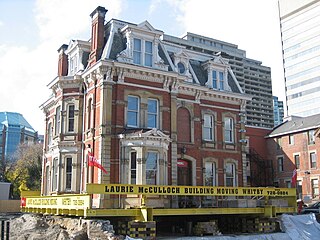
James Cooper House is an historic house in Toronto, Ontario, Canada. In 2008, the house became the heaviest residential structural relocation in Canadian history, when it was moved 20 feet (6.1 m) east and 5 feet (1.5 m) south from its original location. The relocation took place over two phases, moving east on September 25, 2008 and south on December 11, 2008, at a reported cost of CA$1 million.

Old Town is a neighbourhood and retail district in downtown Toronto, Ontario, Canada. It was the first of Toronto's named neighbourhoods, having acquired the moniker no later than 1815, at which time the original town of York was expanding. The old neighbourhood was referred to as "Old Town" by residents, and the new neighbourhood as "New Town". The site still has many buildings dating back to the nineteenth century.
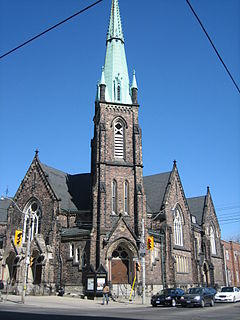
The Jarvis Street Baptist Church is a Baptist church located at the intersection of Gerrard Street and Jarvis Street in downtown Toronto. One of the oldest churches in the city, its congregation was founded in 1818, and the present church constructed in 1875.

Marshall McLuhan Catholic Secondary School is a coeducational, non-semestered, Catholic high school in midtown Toronto, Ontario, Canada managed by the Toronto Catholic District School Board. The school was formally founded in September 1998 to replace De La Salle College Oaklands campus, founded by the De La Salle Brothers in 1851, which was reverted as a private school in 1994. The school property was originally built for the Toronto Hunt Club and later used by the Canadian Armed Forces as the Canadian Forces Staff School until 1994.
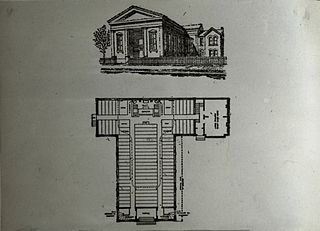
Bond Street Baptist Church built originally in 1848 represented the first permanently established Baptist congregation in the city of Toronto, Canada.

Sherbourne Street is a roadway in Downtown Toronto. It is one of the original streets in the old city of York, Upper Canada.

The National Hotel was a hotel built on the southeast corner of King and Sherbourne streets, in Toronto, Ontario, Canada. Under pressure for condominium apartment redevelopment, the City of Toronto attempted to preserve the building, designating it a heritage site in 2009, but the building was eventually torn down in 2013. The hotel's north and west facades were preserved as part of the new condominium development, examples of "facadism" in Toronto.

George Street is a north–south street in Toronto, Ontario, Canada, from south of Front Street, north to Gerrard Street. Its southern blocks are within the grid of the townsite of the original town of York, Upper Canada. George Street was once one of the most exclusive and expensive addresses in the city. Today, the north end of the street, next to Seaton House men's shelter, is an example of urban blight. The City of Toronto government is redeveloping the street with a new Seaton House institution focused more on long-term care. Several abandoned buildings have been bought by the city, and others have been expropriated to facilitate the redevelopment – the George Street Revitalization Project.



















